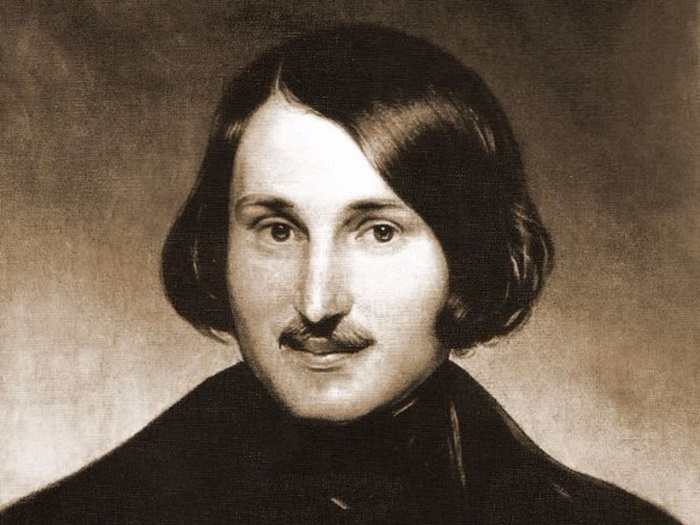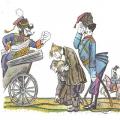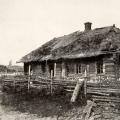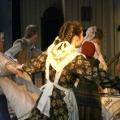The life and work of Nikolai Vasilyevich Gogol: a biography of the mystical writer himself
The unusual and completely incomprehensible personality of this amazing Great Russian writer at all times has been of interest to numerous researchers, historians, cultural figures and simply lovers and admirers of his work. However, the attitude towards him was never unambiguous. Neither during his lifetime nor after his death did he receive absolute recognition. Numerous contemporaries, even among his close friends, considered the writer crazy or on the verge of mental illness. So who is Nikolai Vasilievich Gogol, how did his life go, and what surprises did fate bring, which was not favorable to this truly great man?
All about Gogol: a brief description of the legacy and biography of the writer
Interest in the person of Gogol did not subside from the very beginning of his creative path to the present day, and the role of creative activity in literature in general and Russian literature in particular is invaluable. In one of his letters to his close friend Alexander Tolstoy, he wrote that one should be grateful to fate and God, that they were destined to be born Russians. This shows how patriotic he was, how he loved his homeland. In view of this, he also tried to expose the darkest sides of her life, trying to present them in a comically sarcastic light, which he succeeded very well. All life's questions and problems had a religious-moral or, if you like, moral meaning for him.
At the end of his short life, and he managed to live only forty-three years, Gogol suddenly became imbued with Orthodoxy and the meaning of spirituality. Therefore, I began to write about a responsible and conscious attitude to life. In 1850, shortly before his death, he wrote to his friend, Archpriest Matthew Konstantinovsky, that modern man had lost his meaning, lost his understanding of purpose and supreme goal. He wanted to show his "dark brethren living in the world" that one should not play with fate, because this is not a toy at all.
The life and work of Gogol was always filled not only with deep thoughts about the meaning of life, he turned out to be no stranger to a brilliant lyricist, with the subtle soul of a poet. His folklore plots and images were often drawn from folk legends and tales. They are quite combined with the life realism of his works, creating an unsurpassed symbiosis, it would seem, of two perfect opposites. At the end of his life, Nikolai Vasilievich decided that the highest purpose of any creativity is to lead a person to Christianity and understand God.
However, during his lifetime, Gogol was in most cases perceived as a skilled humorist and satirist, and much of his creative heritage was rethought after his death. Any literary movement that arose later could rightfully attribute him as its own forerunner. Therefore, the significance of his creations, as a contribution to Russian and world literature, is simply colossal. This man went down in history as consciously responsible for the work he did.
Childhood and youth of the Little Russian writer
Everyone who has ever delved into the biographies of famous writers knows for sure that Gogol's real name is Yanovsky. On March 20, 1809, in the parish book of the village of Sorochintsy (now Velikiye Sorochintsy), near the river with the strange name Psel, on the very border of the Mirgorod and Poltava districts, a record was made that a boy was born in the family of the landowner Vasily Afanasyevich Yanovsky, who was named Nikolai , in honor of the famous saint. His father came from an ancient noble Polish family, which was recognized at his request in 1820.
An interesting legend is connected with the mother of Nikolai Vasilyevich, Maria Ivanovna, nee Kosyarovskaya. As his father said, he saw his future wife in a dream, and then found her, at the age of one year. Thirteen years after that, he waited until the bride grew up and at fourteen she would be given to him as his wife. Eleven children were born in the family, but many of them died in infancy. Many believe that the writer's childhood passed in the traditional Little Russian way of life, but this is not entirely true.
Nikoshi's father, Vasily Afanasyevich, was a man of special culture. He simply adored creativity and art, he wrote plays, stories, poems and poems, and then he read them with pleasure in his own impromptu theater from the stage. Perhaps it was his father's stage efforts that made Gogol exactly the person he was. He died in 1825, when the boy was barely sixteen years old. At that time, he had only three sisters, Elizabeth, Anna and Mary.
Education and work: Gogol's life outside his native walls
When the boy Nikosha turned ten, his parents had to think about education. Therefore, he was taken to Poltava and given into the hands of Gavriil Sorochinsky, so that he would prepare him for the gymnasium. At the age of sixteen, on a dark May day on the 21st of 1821, Nikolai Vasilievich entered the Gymnasium of Higher Sciences in Nizhyn, which he repeatedly regretted later, since such a science did not suit him for the future. He was never a good “studio”, therefore he was often beaten with rods, but his natural abilities allowed him to prepare for testing overnight and move from one class to the next.
However, Gogol was definitely lucky with fellow students, he managed to get along with the boys who would become his friends for life. Among them were Nestor Kukolnik, Alexander Danilevsky, Nikolai Prokopovich and others. They jointly subscribed to magazines and literary messengers in a pool, together staged performances, for which Nikolai himself often wrote poems and plays. Already at that time, he began to think about his own destiny, and even in letters to his ardently beloved mother, he writes that his interests extend far beyond the understanding of ordinary inhabitants and even his fellow high school students.
City where little people disappear without a trace: Petersburg G

Already after the completion of the gymnasium and the funeral of his father, in 1828 Nikolai Vasilievich decides to move to St. Petersburg, which his mother warmly supports and even allocates him a monthly allowance. However, among the narrow streets and bridges hanging right in the air, a monstrous, cruel disappointment awaited the writer - no one was waiting for him here, and no one needed him here. He tried to enter the service and the stage, but to no avail. The daily routine discouraged him, and he left the service, the actor never left him. It remained to surrender completely to literature, which he did.
During this period, Gogol discovered that the public was interested in the details of Ukrainian petty-bourgeois and common people's life, so he began to think about writing such stories and even sketched out a plan for the future collection Evenings on a Farm near Dikanka. But before that, he published a book under the pseudonym Alov and with the title "Hanz Kühelgarten" in the twenty-ninth year of the nineteenth century. However, critics crushed it, leaving no stone unturned. Then he went to German Lübeck, hoping to find new inspiration, but returned in the same year in the autumn.
In 1831, Gogol converges with his main friends, who help him break through. For example, it is Zhukovsky who brings him together with such a person as the famous critic and poet of the Pushkin era Pyotr Pletnev. He is also introduced to the master Alexander Sergeevich Pushkin, who treated the works of the young talent with understanding.
Pletnev got Nikolai a job at the Patriot Institute, where he himself served as an inspector, but they paid little there. Therefore, the critic taught Gogol how to earn extra money by giving private lessons in noble aristocratic families. The appointment of Nikolai Vasilievich as an adjunct (deputy or head) at the Department of History of St. Petersburg University can be considered the peak period of Petersburg life. The powerful figure of Pushkin made a huge impression on the young writer, it was practically everything that he could only dream of.
Main works of Gogol
The Petersburg period can be considered the most active in the life of the writer Gogol. This is where most of his writings come from. "Evenings on a Farm near Dikanka" came out in two parts in the thirty-first and thirty-second years. The first included "The Missing Letter", "May Night", "Sorochinsky Fair", as well as the "Evenings ..." themselves, and the second included "Terrible Revenge", "The Night Before Christmas", "The Enchanted Place" and "Ivan Fedorovich Shponka" . Already by 1835, two more collections saw the light, already more mature and serious, with a lesser touch of mysticism and fabulousness. These were "Arabesques", as well as "Mirgorod".
- In 1832, Nikolai Gogol, for the first time after completing his studies at the Nizhyn gymnasium, decides to visit his father's house, visit his sisters and mother. He went through Moscow, where he managed to make acquaintances in literary circles with such people as Sergei Aksakov, Mikhail Pogodin, Mikhail Shchepkin and others. But home comfort did not bring him peace, moreover, it drove the poet's vulnerable soul into anguish. Surrounded by wild nature, he suddenly felt the worthlessness of his "Evenings" and "Mirgorod", unable to plunge the reader into this majestic atmosphere.
- In 1833, Gogol, against all odds, returned to St. Petersburg and decided to open himself in the scientific field. At first, he is overwhelmed by the idea of heading the department of history in Kyiv, at the newly opened Kiev University, but he is not taken there. Therefore, he moves back to Petersburg and sits on the pulpit there.
- By 1834, many researchers and historians attribute the time of writing a crushing blow to embezzlement, hoarding and corruption, in the form of the play "The Government Inspector", which had the effect of a bomb.
- In 1835, new stories were published, "Old World Landowners", the rather terrible and really scandalous "Viy", which still frightens its readers, the famous "Taras Bulba" and the funny, instructive "The Tale of how Ivan Ivanovich quarreled with Ivan Nikiforovich" .
- Not much time later, just two years later, in 1836, Pushkin's Sovremennik also published Portrait, Carriage, and the sentimental Overcoat. At the same time, "The Marriage" came out, as well as a somewhat strange story "Players", which is relevant, like most of Gogol's works, to this day.
- In 1836, Nikolai went abroad, where he began to write his imperishable Dead Souls, which were not half understood by his contemporaries. However, the West, which at first calmed him, again leads to rampant thoughts and feelings. In the summer of 1941, he went to print the first volume to his homeland.
By 1844, Gogol Nikolai Vasilievich was overtaken by unexpected joy, for his colossal merits in terms of Russian literature, he was recognized as an honorary life member of Moscow University. However, he is no longer happy with anything, his work is not going well, the thought of the higher purpose of his talent, divinely presented, leaves an imprint of underestimation of his deeds. In a spiritual crisis and torment, Gogol writes a will and burns the second volume of "dead souls", which he will never restore.
The influence of travel abroad on the worldview of the writer
In 1847, Nikolai Vasilyevich, already in a complete disorder of feelings and thoughts, compiled another book, which his friend critic Pletnev helped to publish. It was "Selected places from correspondence with friends." It is in this book that one can trace the peak religious mood of the Little Russian writer, who is more and more plunging into a spiritual fever. Then the Slavophiles and Westernizers just appeared on the arena of Russian literature and history, but Gogol did not join any of the currents, considering it undivine.
The last book failed, by and large, because of the mentoring and didactic tone. This was well understood by Gogol himself, about which he repeatedly wrote to Pletnev. After a while, he calms down, and then decides to visit Jerusalem and the Holy Sepulcher, which he does in 1847-1849. However, this did not bring him the expected reassurance. He returned home to the village to his mother, then spent some time in Moscow, Kaluga and Odessa.
Personal life and death of Nikolai Vasilyevich: the memory of people for centuries

Never looking for wealth or luxury, not even having his own house, Gogol was never married. He was devoted only to the only woman of his life - literature, and she was able to answer him the same and make him a classic during her lifetime. However, there were still two women in the life of this handsome and even very interesting man.
Favorite women
You can’t call Gogol handsome, but he was still a dandy. Contrary to popular misconceptions, he did not wear his dark caped cloak at all times. He could put on purple pants and a yellow vest, and complement the look with a turquoise camisole. In general, he was a real eccentric. His first love was the royal maid of honor Alexandra Rosset, in the marriage of Smirnov, with the face of a real angel and the same manners.
He loved her tenderly and devotedly, like a dog to a good mistress, but he could not confess his feelings, especially since she was insanely far from him in the ranking list. The second time, Nikolai Vasilyevich fell in love much later, almost before his death, with his own cousin Maria Sinelnikova. Visiting with her mother during her illness, he ended up in her estate Vlasovka, but these relations never developed, since Gogol was occupied with more spiritual issues than carnal and worldly ones.
The death of a brilliant writer and the memory of him
Beginning in the winter of the 52nd year of the nineteenth century, Nikolai Vasilievich settled in the house of his close friend Alexander Tolstoy, who received many guests, including Matthew Konstantinovsky, the Rzhev archpriest, was there. It was this man who was the only one who read the second volume of Dead Souls. He demanded to destroy several chapters from there, as well as "Selected Places ...", due to the special "harmfulness" of the book.
All this had such an impact on Gogol that he decided to completely stop writing and began to fast from February 5, a week before Lent began. On February 12, at night, he woke up the servants, ordered to heat the stove and bring his briefcase. He burned all the sketches and notebooks, and in the morning he lamented to Tolstoy that he was going to burn only unnecessary, prepared in advance, but the demon urged him to burn everything together. On February 18, he is no longer able to move and walks, he just lies in bed, and on February 21, 1852, the great Russian writer Nikolai Vasilyevich Gogol passed away.
The genius creator was buried on February 24 in the university church, and buried in the cemetery of the Danilov Monastery in Moscow, where a two-part tombstone was installed: a black marble slab and a massive bronze cross. On three sides of the plate there are passages from the gospel, and on the fourth side there is an indication of the name, date of birth and death. In the early thirties, this monastery was closed and the necropolis was dismantled. A year later, on May 31, Gogol's grave was opened, and the remains were reburied at the Novodevichy Cemetery, where they are to this day.
Numerous streets, squares, avenues and other geographical features of cities and villages of our vast Motherland, as well as far beyond its borders, are named after Nikolai Vasilyevich Gogol. Several stamps and commemorative commemorative coins were dedicated to him, and there are at least fifteen monuments to him around the world. There are several feature and documentary films that also tell about the fate of the writer, covering it from different angles.
Interesting facts about the writer's life

Many strange, sometimes mystical and frightening stories are connected with this amazing man, whose secrets of personality no one has been able to unravel, despite the passage of more than two hundred years since his death. Many look like outright nonsense, but some suggest some thought.
- It seems to many that a figure in a raincoat, as Gogol is most often portrayed, must necessarily be thin and tall. He was thin, it is true, but his height reached one meter and sixty-two centimeters. He had narrow shoulders, crooked legs and thin dark hair.
- Gogol's character is described by a contemporary with such "zealous diversity" that it immediately becomes clear that he was a secretive person, hardly opening his soul to anyone he met. However, he had a good heart, and therefore he always helped those who were more in need, even when it turned out to be to the detriment of himself.
- Like his late father, Nikolai Vasilievich often heard voices and saw incomprehensible phenomena, which he rarely told others about, he was afraid of being recognized as crazy. He suffered from nervous attacks, after which he had prolonged depressions, which may indicate manic psychosis, if not early schizophrenia.
The Creator was haunted all his life by the panic fear of being buried alive. It was rumored that it was precisely for this reason that he slept half-sitting, so that by chance he would not be considered dead. After the funeral, during the exhumation of the body, it turned out that there was no skull in the grave, at least this was claimed by the Soviet poet and writer Vladimir Ledin. This gave rise to many legends that he was buried in a lethargic sleep. However, most likely, this was evidence of ordinary looting. It was missing a boot, a rib, a piece of a frock coat, which were probably simply stolen into some kind of creepy souvenirs.
 “Lefty” - a summary of the work N
“Lefty” - a summary of the work N Turgenev, "Biryuk": a summary
Turgenev, "Biryuk": a summary Comedy A.N. Ostrovsky "Poverty is not a vice": a summary of the work
Comedy A.N. Ostrovsky "Poverty is not a vice": a summary of the work